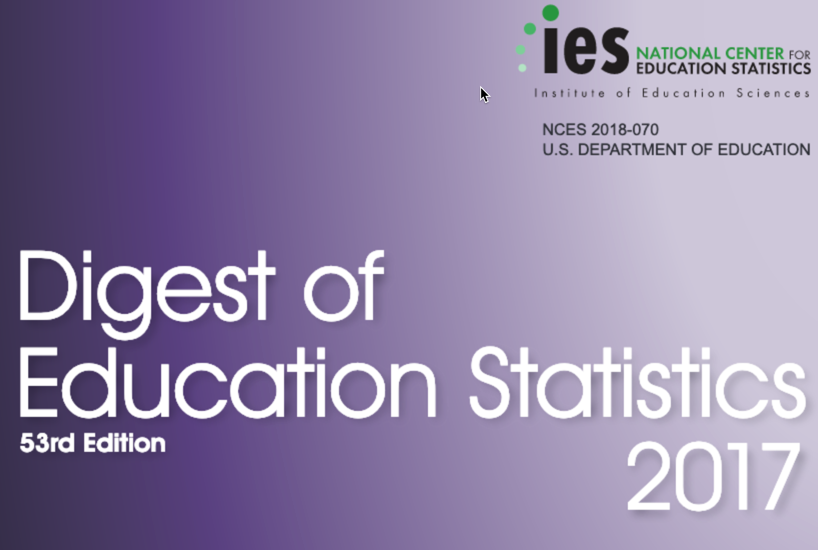Just Released: Digest of Education Statistics 2017 (53rd Edition)
From the National Center for Education Statistics:
The Digest of Education Statistics is a compilation of a wide array of data about education. Compiled by the National Center for Education Statistics (NCES), the Digest is a comprehensive statistical reference for all levels of education, from prekindergarten through graduate school. Data cover a variety of topics, including the number of schools and colleges, teachers, enrollments, and graduates, in addition to educational attainment, finances, and federal funds for education, libraries, and international comparisons. The new and updated statistical tables that are included in the Digest are released on a rolling basis. A complete volume that includes text and graphics is released annually.
NCES released Digest of Education Statistics 2017 today (January 30, 2019). Key findings on the core topics of enrollment and educational attainment include the following:
- In fall 2017, public schools enrolled 35.6 million elementary students and 15.1 million secondary students, according to projections. Public elementary enrollment is expected to increase 3 percent between 2017 and 2027, and public secondary enrollment is expected to increase 2 percent over the same period;
- Between 1990 and 2016, the status dropout rate declined from 12.1 percent to 6.1 percent. (The status dropout rate is the percentage of 16- to 24-year-olds who have not completed high school and are not enrolled in school.) During this period, the status dropout rate for Black 16- to 24-year-olds declined from 13.2 percent to 6.2 percent and the rate for Hispanic 16- to 24-year-olds declined from 32.4 to 8.6 percent. In 2016, the status dropout rate for White 16- to 24-year-olds (5.2 percent) was lower than the rate for Hispanic 16- to 24-year-olds, but it was not measurably different from the rate for Black 16- to 24-year-olds;
- Fall enrollment in degree-granting postsecondary institutions was 12 percent higher in 2016 (19.8 million) than in 2006 (17.8 million). The overall increase between 2006 and 2016 reflects an increase of 18 percent between 2006 and 2010, followed by a decrease of 6 percent between 2010 and 2016;
- From fall 1976 to fall 2016, the percentage of Hispanic students rose from 4 percent to 18 percent of all U.S. residents enrolled in degree-granting postsecondary institutions, and the percentage of Asian/Pacific Islander students rose from 2 percent to 7 percent. The percentage of Black students increased from 10 percent in 1976 to 14 percent in 2016, but the 2016 percentage reflects a decrease since 2011, when Black students made up 15 percent of all enrolled U.S. residents. The percentage of American Indian/Alaska Native students was higher in 2016 (0.8 percent) than in 1976 (0.7 percent);
- Between 2007 and 2017, the percentage of 25- to 29-year-olds who had completed high school rose from 87 percent to 92 percent. During the same period, the percentage with a bachelor’s or higher degree increased from 30 percent to 36 percent.
Direct to Browse Full Tex Document
Direct to Browse the Tables and Figures
Direct to Full Text (905 pages; PDF)
Filed under: Data Files, Libraries, News
About Gary Price
Gary Price (gprice@gmail.com) is a librarian, writer, consultant, and frequent conference speaker based in the Washington D.C. metro area. He earned his MLIS degree from Wayne State University in Detroit. Price has won several awards including the SLA Innovations in Technology Award and Alumnus of the Year from the Wayne St. University Library and Information Science Program. From 2006-2009 he was Director of Online Information Services at Ask.com.



